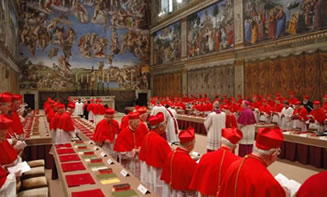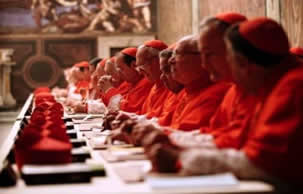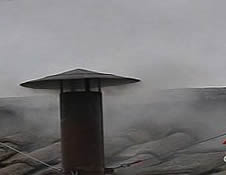«As we have been renewed, O Lord,
with the supreme Sacrament of salvation,
the Body and Blood of your Only Begotten Son,
may the wondrous grace of your majesty
gladden us with the gift of a shepherd
who will instruct your people by his virtues
and imbue the minds of the faithful with the truth of the Gospel.
Through Christ our Lord."
(Prayer after Communion during the during the time of election of a new Pope.) |
 Conclave is the meeting of cardinals convoked with the purpose of electing a new Pope. The election of a Pope is Conclave is the meeting of cardinals convoked with the purpose of electing a new Pope. The election of a Pope is  conducted behind closed doors, in "conclave" (from the Latin cum + clavis: "with key"). The cardinals participating in the conclave have no contact with the outside world. This practice was begun by Pope Gregory X in 1274 to eliminate external interference and pressure on the electoral process, since his own election had already been extended for almost 3 years. conducted behind closed doors, in "conclave" (from the Latin cum + clavis: "with key"). The cardinals participating in the conclave have no contact with the outside world. This practice was begun by Pope Gregory X in 1274 to eliminate external interference and pressure on the electoral process, since his own election had already been extended for almost 3 years.
In 1996, Bl. John Paul II promulgated "On the Vacancy of the Holy See and the Election of the Roman Pontiff," in which he confirms and makes the previous legislation precise and makes some minor changes.
 The Pope is chosen by the Church of Rome and not by the College of Bishops. The Pope is chosen by the Church of Rome and not by the College of Bishops.
The reason for this is that the Pope is the bishop of Rome. As such, he is the head of the episcopal college and the visible head of the Church. For this reason, the Pope is not the representative of the bishops. Just as the Apostles did not choose Peter, the bishops do not choose the Pope.
 The Cardinales who elect the Pope. The Cardinales who elect the Pope.
They are specifically linked to the Church of Rome in some way: by being bishops of dioceses close to Rome, by being members of the Roman curia, or by incorporation into the Roman clergy. In reality, the majority of cardinals are pastors of churches geographically distant from Rome, but they are at the same time incorporated into the local Roman clergy. Each cardinal is assigned as a "titular" to a church of Rome, of which he is seen as an honorary pastor. This relationship with Rome preserves the tradition which comes from the first centuries, according to which the Roman clergy, with the help of nearby bishops, would choose the new bishop of Rome. At the same time, the college of Cardinals, in having its members come from more than 50 countries, manifests the catholicity of the Church in the election of a Pope.
The conclave must follow strict and detailed rules that regulate who can be present. They protect from influences and interference, and even specify how to write and fold the ballot. Some infractions, like the violation of secret, simony, yielding to secular authority, carry the penalty of excommunication. secular authority, carry the penalty of excommunication.
Bl. John Paul II stipulated that the conclave should be conducted in an atmosphere of prayer, free from worldly interests. He also asked the faithful to pray for the election.
*The electors are cardinals
*Cardinals older than 80 years old before the death of the Roman Pontiff or before the day on which the See becomes vacant are excluded from the conclave
*Paul VI limited the conclave to 120 cardinals
John Paul II installed a slightly higher number, but the number is rapidly reduced by the number of cardinals who are close to 80.
* All those who enter the conclave, including personal assistants, must solemnly promise "absolute and perpetual secrecy" Even the notes taken during the election must be handed in and burned. The cardinals can say nothing about the election without the explicit permission of the new Pope.
 Location of the Conclave: The Sistine Chapel, within Vatican City. This chapel is also famous for the frescoes that cover its walls and ceiling. John Paul II thought that this chapel, particularly the famous fresco by Michelangelo, "The Last Judgment" offers an environment that lends to thinking of God and the responsibility of the election. Before the election, two conferences are given to the cardinals regarding the problems that the Church is facing and about the need for careful discernment in choosing the new Pope. Location of the Conclave: The Sistine Chapel, within Vatican City. This chapel is also famous for the frescoes that cover its walls and ceiling. John Paul II thought that this chapel, particularly the famous fresco by Michelangelo, "The Last Judgment" offers an environment that lends to thinking of God and the responsibility of the election. Before the election, two conferences are given to the cardinals regarding the problems that the Church is facing and about the need for careful discernment in choosing the new Pope.
The cardinals will sleep within Vatican City, in Domus Sanctae Marthae. From there they will be transported daily to the Sistine Chapel.
 *The election will be by secret vote *The election will be by secret vote
*Bl. John Paul II eliminated the possibility of election by acclamation and election by delegation when the majority of the cardinals delegate the election to a few). Bl. John Paul II considers that these two methods of election do not lend to the current situation.
*2/3 of the votes are necessary for election. If after a specified number of votes, the election is not decided, the election, could be decided by a simple majority.
*After each vote, the ballots are burned. From St. Peter's Square, people observe the chimney. When the smoke from the burned ballots is black, it means that they have not yet chosen a new Pope. *When the smoke is white it means that an new Pope has been elected. The white smoke is produced by adding wet straw to the ballots that are burned. Then the bells are rung with great joy. Habemus Papa! (We have a Pope).
*The newly elected becomes Pope immediately after he accepts.
*When the new Pope gives the name by which he will be known, the cardinals declare their obedience to him.
*Immediately afterwards it is proclaimed publically.
 Resignation of a Pope Resignation of a Pope
Popes have traditionally maintained in the Petrine office until their death, but the Pope does have the liberty of resigning. This possibility is found in Canon Law. If this happens the Holy Sea becomes vacant and a new Pope must be elected.
*The first Pope to resign in the Church's history was probably St. Pontian (230-235), he was arrested and sent to the salt mines, and in order for a successor to be able to be elected in Rome, he resigned his office. Another Pope was elected and tradition tells us that St. Pontian outlived his successor.
*St. Pope Celestine V resigned in 1294. After five months in the Petrine Office he returned to being a hermit, the life he led before being elected.
*For it to be a valid resignation it has to be done freely, properly manifested and it does not have to be accepted by anyone. No person  or group, not even a council of bishops can force the Pope to resign. or group, not even a council of bishops can force the Pope to resign.
 The Chimney (the smoke that announces that the ballots have been burned in the conclave) The color of the smoke indicates if a Pope has been elected: Black¬¬: no / White: yes. The burnt paper usually produces a black smoke. To produce the white smoke wet straw is added to the ballots. In past elections it has been difficult to distinguish the color of the smoke. Now, when the Pope is elected, along with the white smoke there will be a ringing of the bells. The Chimney (the smoke that announces that the ballots have been burned in the conclave) The color of the smoke indicates if a Pope has been elected: Black¬¬: no / White: yes. The burnt paper usually produces a black smoke. To produce the white smoke wet straw is added to the ballots. In past elections it has been difficult to distinguish the color of the smoke. Now, when the Pope is elected, along with the white smoke there will be a ringing of the bells.
 Some historic data in regards to the Election of Popes Some historic data in regards to the Election of Popes
We do not find any specific procedure for the election of the successor of Peter in Holy Scriptures nor in the Apostolic Tradition. The first Popes probably chose their own successors. Later on a procedure was established to elect the Bishop of Rome.
*The historian Eusebius recounts the election of Pope St. Fabian in the year 236. Nobody thought of Fabian as a candidate to the papacy, but suddenly a dove came and rested on his head and all understood it was a sign from God. The election was by acclamation.
*In 1059, Pope Nicholas II decreed that only the Bishop Cardinals be the ones to elect the Pope.
*In the Lateran Council of 1179 it was established that a 2/3 majority vote by the Cardinals was necessary for the Pope to be elected. This tradition is still in effect today.
*The longest papal election in history took almost three years (1268-1271). Tired of waiting, the local authorities sealed the doors of the palace the 18 electors were in forcing them to end the process of election. (Raynald, Ann. Eccl. ad ad. 1271).
*The new Pope, Gregory X, wanted to avoid this situation from happening again and he made a legislative act in 1274 during the Second Council of Lyons. He established that the electors must be closed in "with keys" until they decide who the next Pope would be. In the Constitution "Ubi Periculum", the word "conclave" is used for the first time in relation to the election of a Pope. The rules established in this constitution were severe, to the point of imposing a very strict diet to the Cardinals if they did not elect a new Pope promptly. Some of this rules have changed, but the concept of the conclave has prevailed until today.
*In the 20th Century various Popes have made some minor changes to the Constitution.
*In 1975, Pope Paul VI promulgated some changes in the decree "Romano Pontifici Eligendo". John Paul II and Benedict XVI have also made some changes.
|



 conducted behind closed doors, in "conclave" (from the Latin cum + clavis: "with key"). The cardinals participating in the conclave have no contact with the outside world. This practice was begun by Pope Gregory X in 1274 to eliminate external interference and pressure on the electoral process, since his own election had already been extended for almost 3 years.
conducted behind closed doors, in "conclave" (from the Latin cum + clavis: "with key"). The cardinals participating in the conclave have no contact with the outside world. This practice was begun by Pope Gregory X in 1274 to eliminate external interference and pressure on the electoral process, since his own election had already been extended for almost 3 years. secular authority, carry the penalty of excommunication.
secular authority, carry the penalty of excommunication. *The election will be by secret vote
*The election will be by secret vote